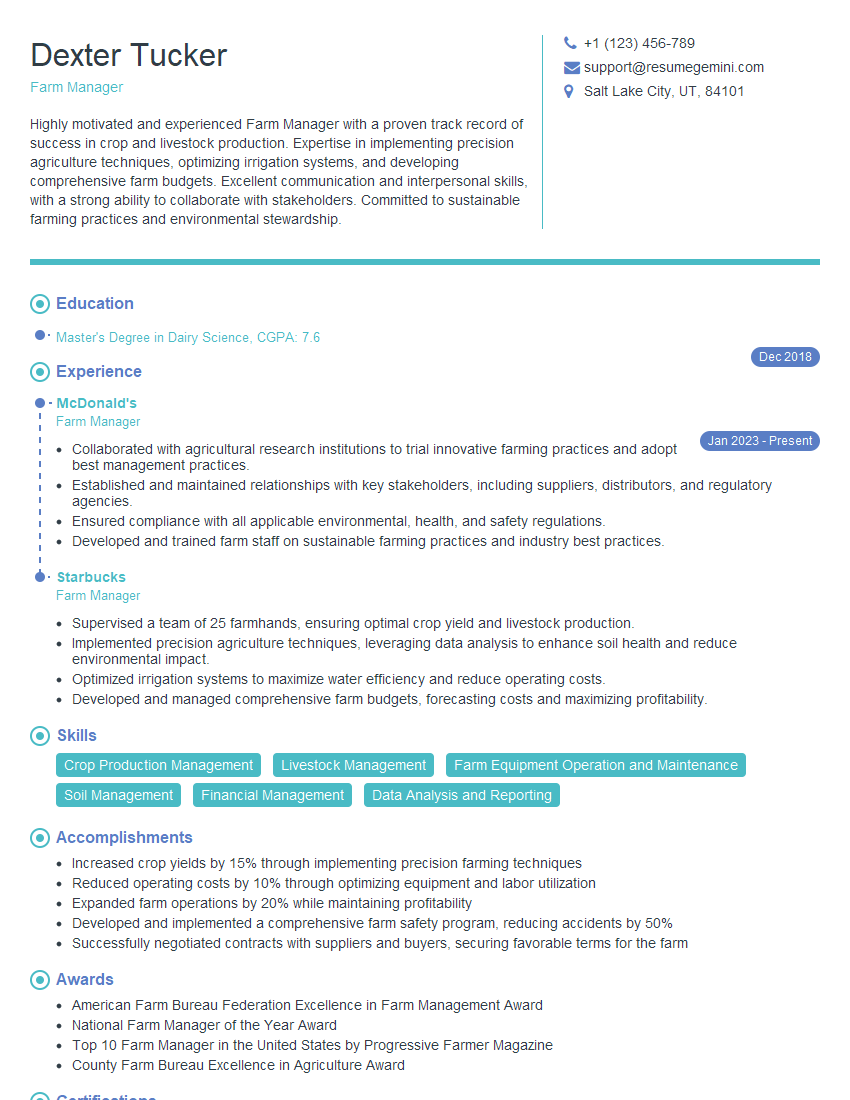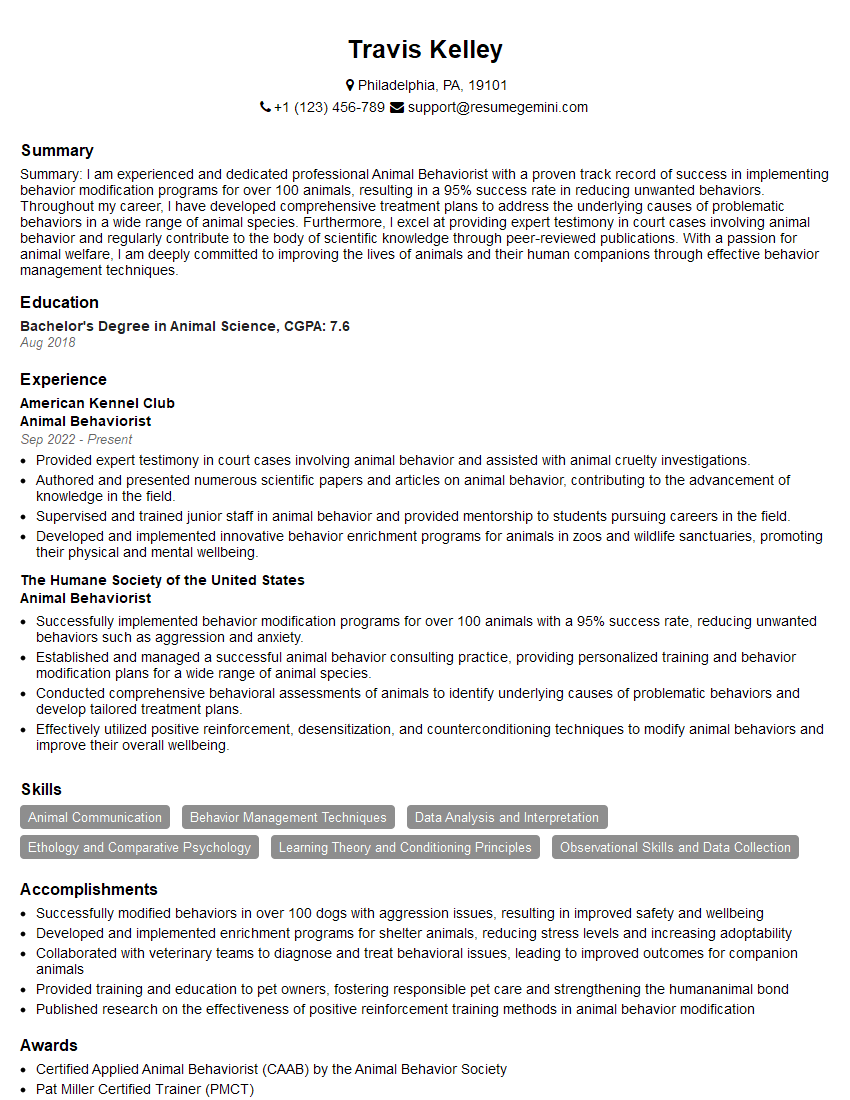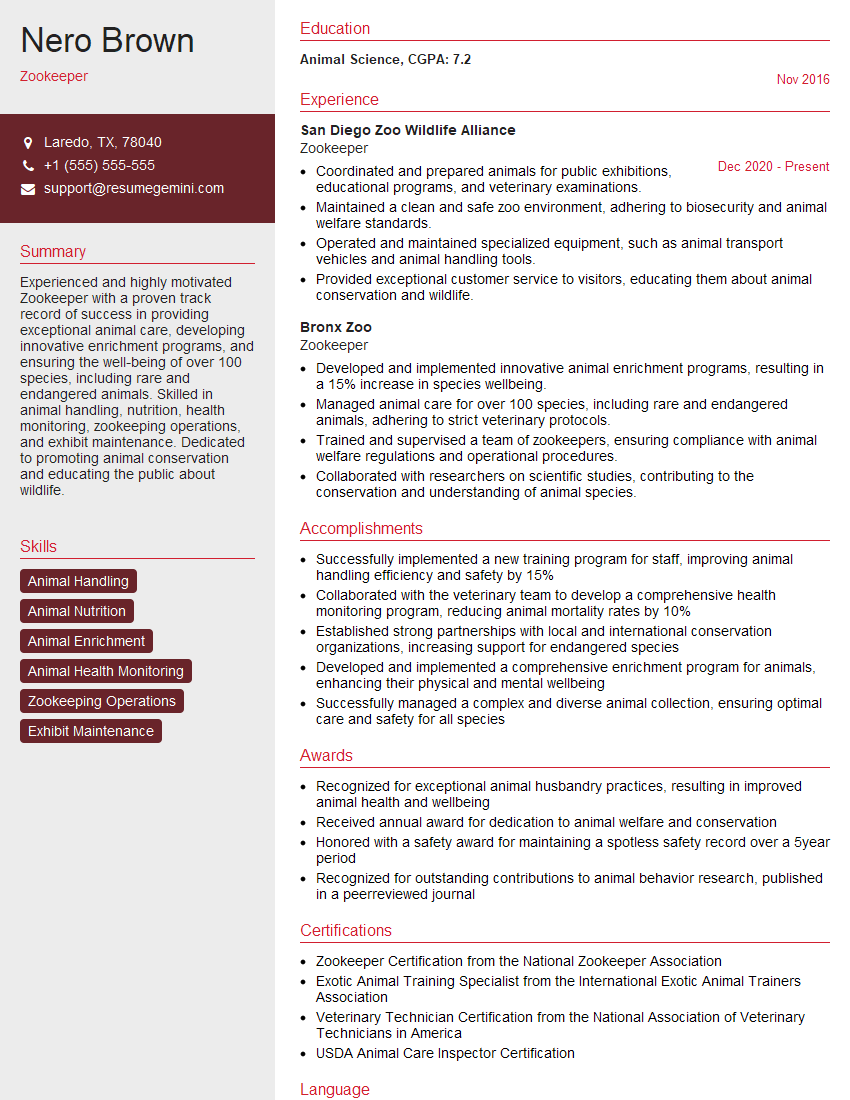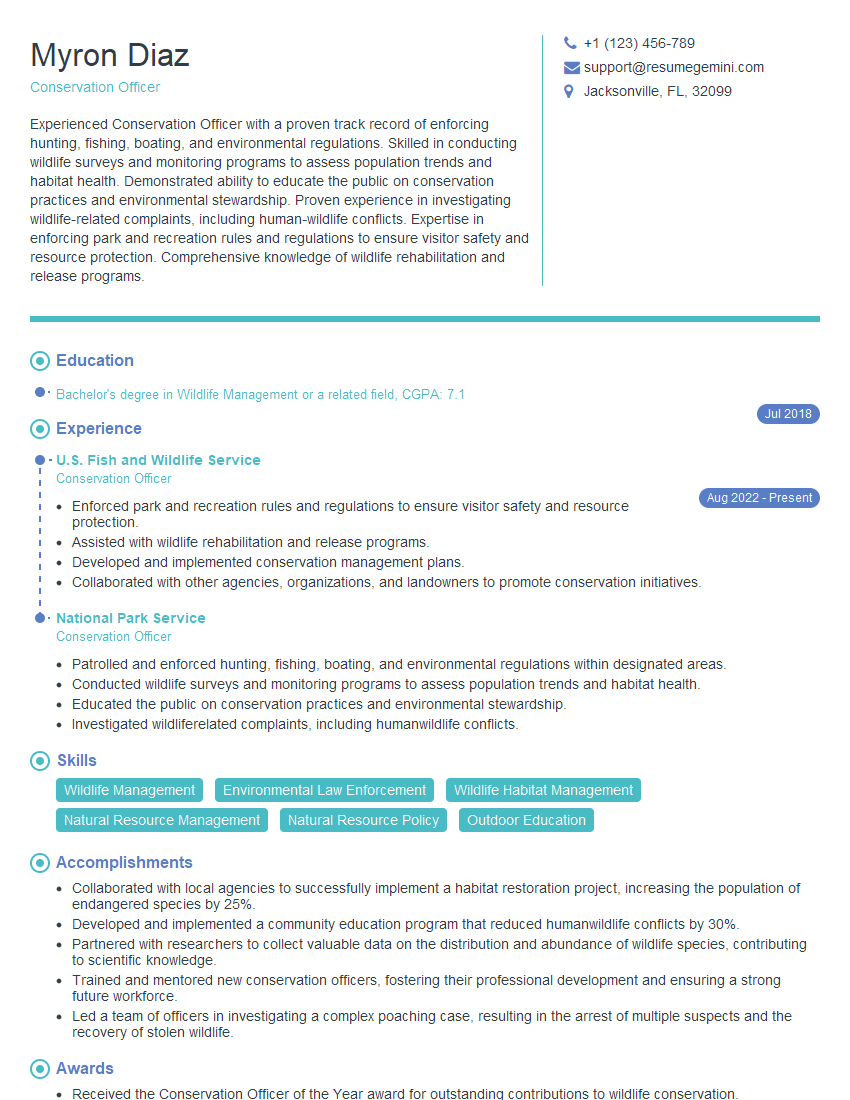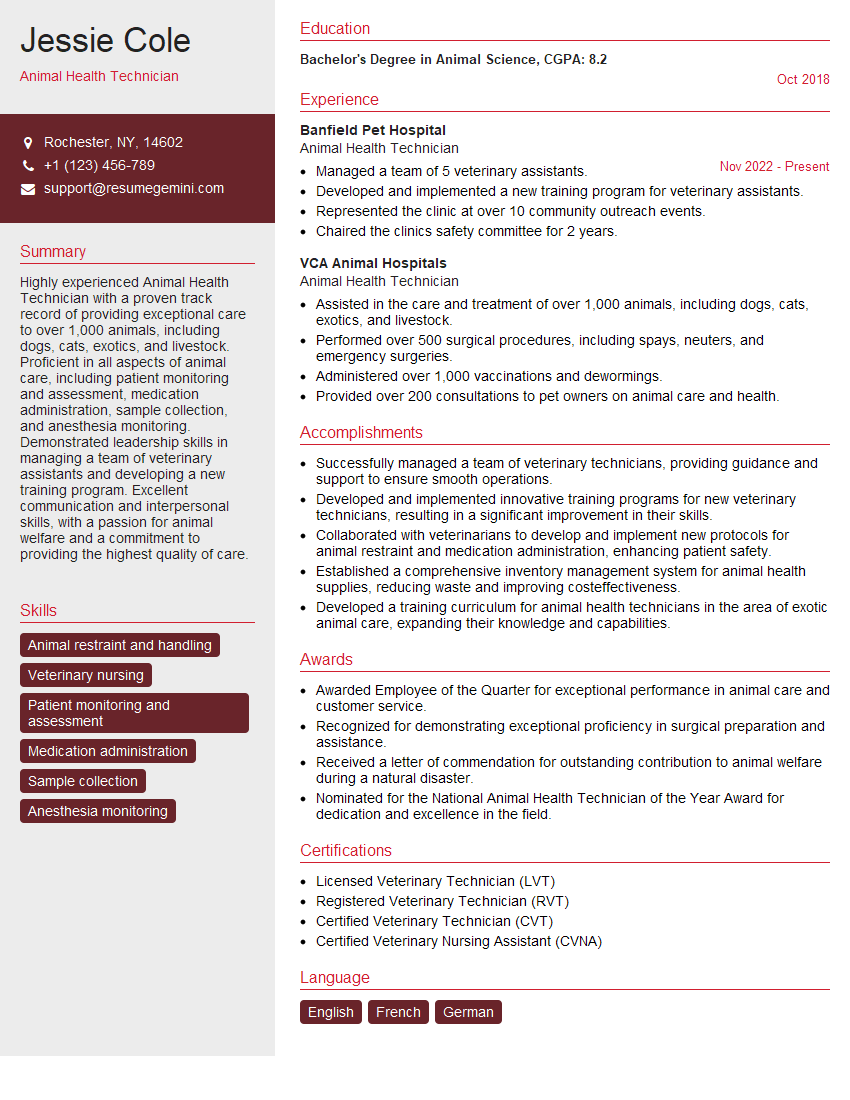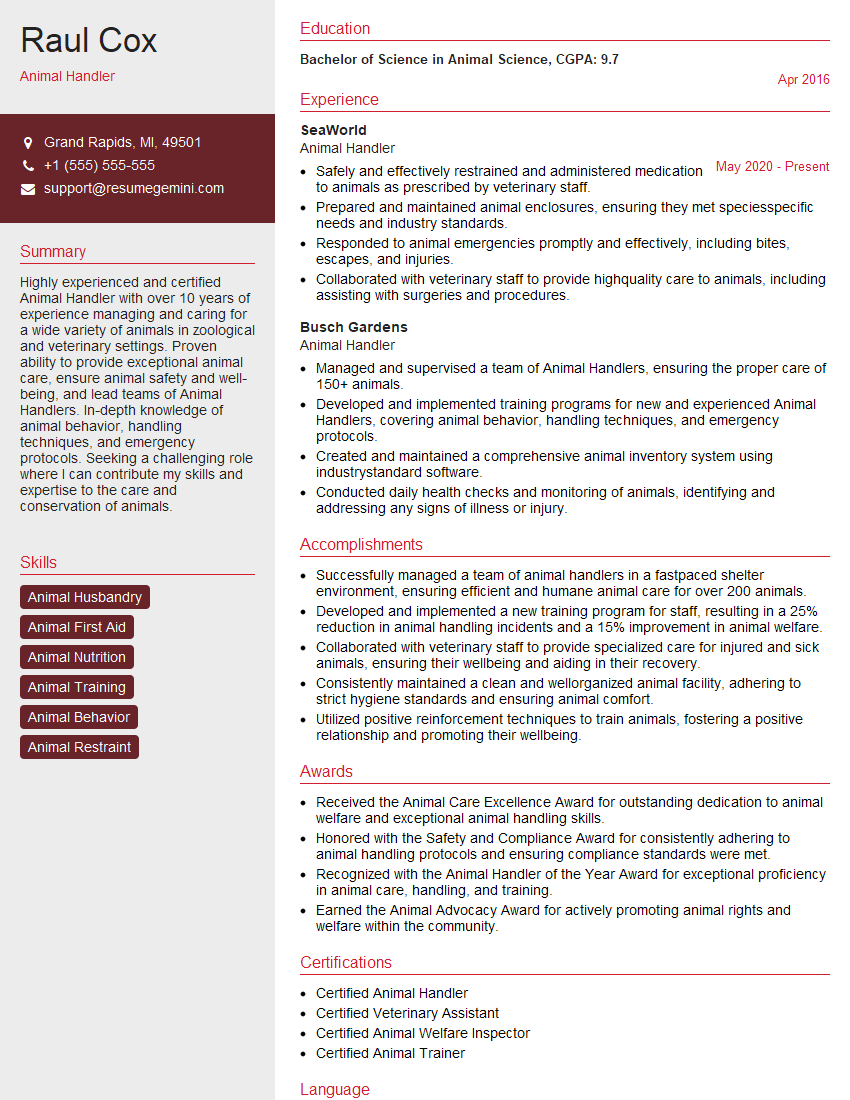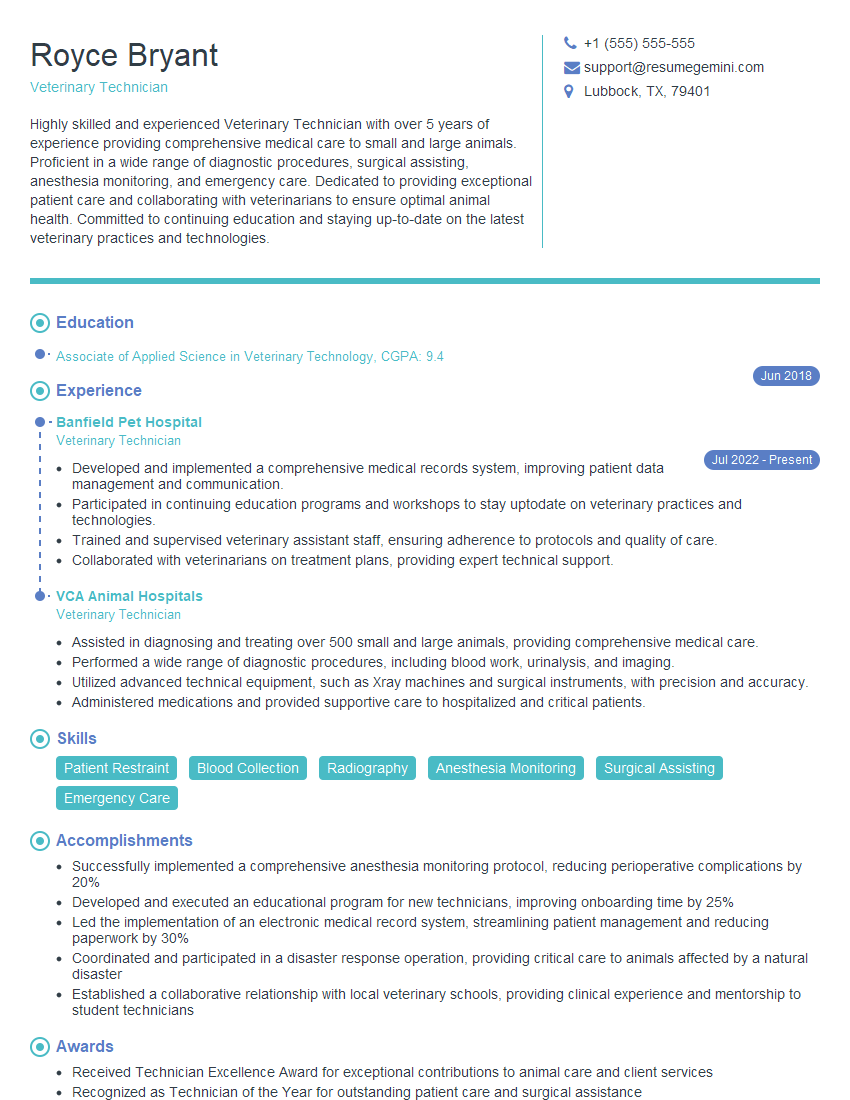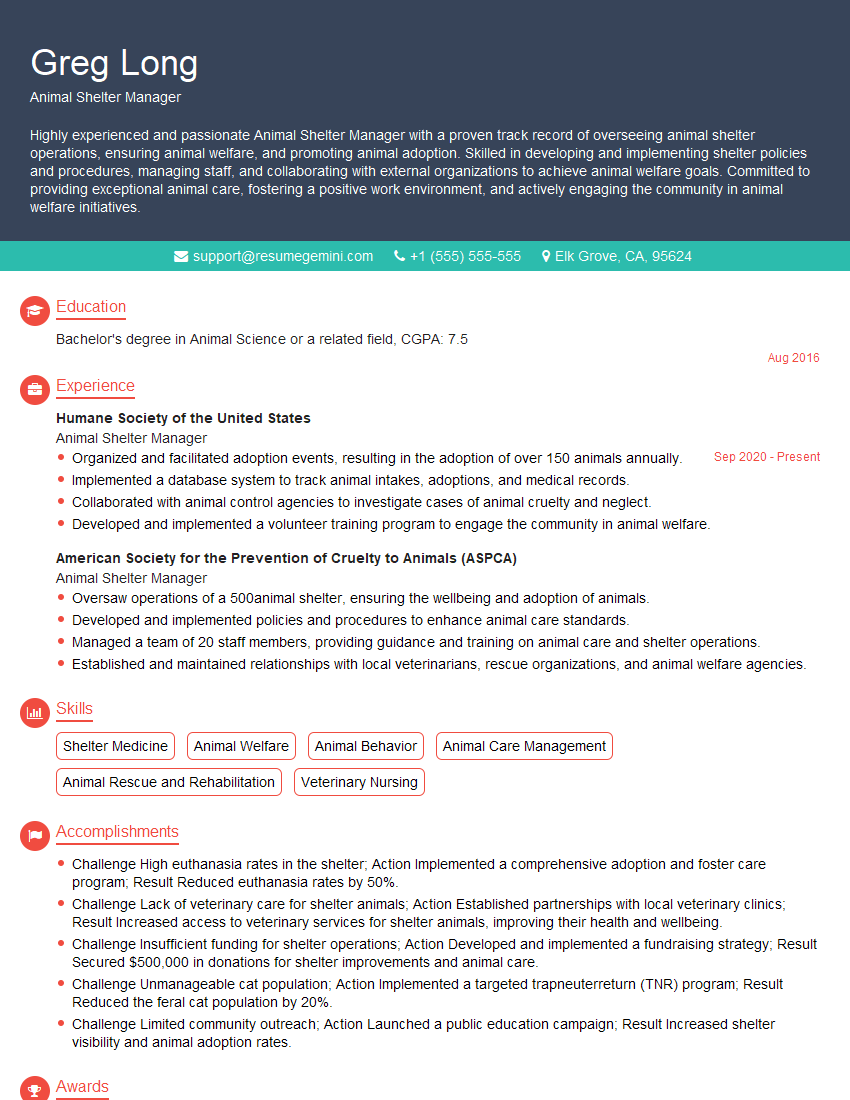Every successful interview starts with knowing what to expect. In this blog, we’ll take you through the top Animal Handling and Husbandry interview questions, breaking them down with expert tips to help you deliver impactful answers. Step into your next interview fully prepared and ready to succeed.
Questions Asked in Animal Handling and Husbandry Interview
Q 1. Describe your experience handling different animal species.
My experience encompasses a wide range of animal species, from common domestic animals like dogs and cats to more specialized species including primates, birds of prey, and reptiles. I’ve worked in various settings, including veterinary clinics, zoos, wildlife rehabilitation centers, and private animal sanctuaries. Handling each species requires a unique approach, understanding their individual temperaments, body language, and potential hazards. For example, handling a dog involves understanding canine communication – a relaxed posture versus a tense, aggressive stance. Working with primates requires extra caution due to their strength and potential for unpredictable behavior. With birds of prey, understanding their sharp talons and beaks is paramount, requiring specialized handling techniques and equipment. Each experience has enhanced my ability to adapt my approach based on the animal’s specific needs and my assessment of the situation.
- Dogs and Cats: Routine examinations, vaccinations, and behavioral assessments.
- Primates: Assisted with medical treatments, enrichment activities, and observational studies, utilizing appropriate restraint techniques.
- Birds of Prey: Experience in handling and caring for raptors, including weighing, administering medication, and maintaining flight fitness.
- Reptiles: Successfully handled and cared for various species, understanding their specific thermoregulatory and dietary needs.
Q 2. Explain the importance of animal enrichment.
Animal enrichment is crucial for maintaining physical and psychological well-being. Animals in captivity, especially, need stimulation to prevent boredom, stress, and the development of abnormal behaviors (stereotypies). Enrichment provides opportunities for animals to express natural behaviors, engage their senses, and improve their overall quality of life. Think of it like providing a challenging and engaging environment for a human – it’s not enough to simply provide food and shelter.
There are several types of enrichment: environmental (providing hiding places, climbing structures, varied substrates); social (introducing compatible animals for interaction); sensory (providing varied textures, sounds, smells); and foraging (making food harder to access, encouraging natural foraging behaviors).
Example: A zoo might provide a climbing structure for primates, hiding places for rodents, and puzzle feeders for large cats to encourage problem-solving and prevent boredom. For a domestic cat, a scratching post, interactive toys, and a window perch offer similar benefits.
Q 3. How do you identify and respond to signs of illness or injury in animals?
Identifying illness or injury relies on keen observation and understanding species-specific signs. Changes in behavior, appetite, posture, and elimination patterns are crucial indicators. Physical examination may reveal external wounds, swelling, or abnormalities. For example, lethargy, loss of appetite, and changes in fecal consistency can be signs of gastrointestinal issues. A limping gait suggests musculoskeletal problems. Respiratory distress is signaled by rapid breathing, open-mouth breathing, and coughing.
My response is tailored to the situation: immediate first aid if necessary (e.g., cleaning a wound, stabilizing a fracture); contacting a veterinarian; implementing supportive care until professional help arrives. Detailed record-keeping of observations is essential for accurate diagnosis and treatment monitoring.
Q 4. What are the common methods for safe animal restraint?
Safe animal restraint is crucial for both animal and handler safety. The method chosen depends heavily on the species, size, temperament, and the reason for restraint (e.g., examination, medication, transport). Techniques range from simple approaches like gentle handling for docile animals to more complex methods using specialized equipment for larger or more aggressive species.
- Dogs: Using a leash and collar, or a gentle muzzle if necessary.
- Cats: Securely holding the scruff of the neck while supporting the body.
- Larger mammals: Using specialized equipment like halters, ropes, and capture poles. Tranquilization may be necessary in certain situations.
- Reptiles: Using hooks or tongs to safely handle and restrain.
Safety is paramount; never attempt to restrain an animal beyond your capabilities. Proper training and the assistance of colleagues are vital when working with potentially dangerous animals.
Q 5. Detail your experience with animal medication administration.
My experience includes administering various medications, both orally and parenterally (via injection). I am proficient in administering oral medications (pills, liquids), subcutaneous injections, intramuscular injections, and intravenous injections (under veterinary supervision). I always follow strict protocols and safety procedures, including proper drug calculations, adhering to the veterinarian’s instructions, and maintaining accurate records. Accurate record-keeping is essential, including dosage, route of administration, date, and time, and any observed adverse reactions.
Example: Administering oral medications to a cat requires careful handling to avoid scratches, while administering an intramuscular injection in a dog requires proper injection technique to prevent tissue damage. Each species and medication requires a unique approach to ensure the safety and efficacy of the treatment.
Q 6. Describe your knowledge of animal nutrition and dietary requirements.
Animal nutrition is a cornerstone of animal health and well-being. Dietary requirements vary widely depending on the species, age, size, activity level, and reproductive status. Understanding the nutritional needs of each animal is crucial for maintaining optimal health and preventing disease. Knowledge includes recognizing appropriate feed types, calculating appropriate quantities, and identifying signs of malnutrition or dietary imbalances.
Example: A growing puppy requires a diet high in protein and calcium, whereas a senior dog might need a diet lower in calories and higher in fiber. Herbivores, carnivores, and omnivores have drastically different nutritional needs. Understanding these differences and tailoring diets accordingly is paramount.
I am proficient in calculating dietary requirements based on body weight, activity level, and life stage, and in adapting diets to meet specific health conditions.
Q 7. How do you maintain a clean and sanitary environment for animals?
Maintaining a clean and sanitary environment is critical for preventing disease transmission and ensuring animal well-being. This includes regular cleaning and disinfection of enclosures, feeding areas, and water sources. Proper waste disposal is essential. The frequency and methods of cleaning vary depending on the species and the type of enclosure. In many cases, this also includes controlling pest populations.
Example: For a dog kennel, regular cleaning and disinfecting of the floor and bedding is crucial, while for a primate enclosure, the cleaning protocols may include removing waste, cleaning surfaces, and maintaining appropriate humidity levels.
Following established hygiene protocols and using appropriate cleaning agents are critical in preventing the spread of disease and maintaining a healthy environment for the animals under my care.
Q 8. Explain your understanding of animal behavior and its impact on handling.
Understanding animal behavior is fundamental to safe and effective handling. Animals communicate through various cues – body language, vocalizations, and even scent – that reveal their emotional state and intentions. A fearful animal might exhibit flattened ears, tucked tail, and rapid breathing, while an aggressive animal might display piloerection (raised fur), bared teeth, and stiff posture. Recognizing these signals allows handlers to anticipate potential problems and adjust their approach accordingly. For example, a horse exhibiting signs of fear might require a gentler, slower approach, whereas a dog displaying aggression might need to be given more space and a calming, low-pitched voice. Ignoring these cues can lead to accidents and injuries for both the animal and the handler. Effective handling relies on interpreting and responding appropriately to these behavioral indicators.
Q 9. How do you handle aggressive or fearful animals?
Handling aggressive or fearful animals requires a calm, patient, and strategic approach. Safety is paramount. Never approach an aggressive animal directly; instead, assess the situation from a safe distance. Understanding the *root cause* of the aggression or fear is vital – is it pain, fear of humans, territoriality, or a medical condition? With fearful animals, slow, deliberate movements, combined with offering calm verbal reassurances, can help build trust. Avoid sudden movements or loud noises. Aggressive animals might require specialized equipment like muzzles or restraining devices, used only by trained personnel. In all situations, prioritize creating a safe environment for both the animal and the handler. If the situation cannot be safely managed, professional help should be sought immediately.
For example, when handling a fearful cat, I might use a towel to gently restrain it for examination, avoiding any quick movements. If faced with a dog displaying aggression, I might use a long leash to maintain distance while assessing the situation and developing a safe handling plan, perhaps with the assistance of a vet or behavioral specialist.
Q 10. What safety precautions do you take when handling animals?
Safety is the cornerstone of animal handling. Precautions vary depending on the species and individual animal, but some general principles always apply:
- Appropriate Personal Protective Equipment (PPE): This includes sturdy gloves, long sleeves and pants, eye protection, and, in some cases, protective boots or vests, depending on the animal’s size and potential danger.
- Proper Restraint Techniques: Learning and using species-appropriate restraint techniques is crucial. This could include using halters, leashes, nets, or other specialized tools. Improper restraint can cause injury to both the animal and the handler.
- Environmental Safety: Ensuring a secure environment is essential. This means working in a well-lit area, free from distractions and potential hazards, with appropriate barriers if necessary.
- Knowing the Animal’s History and Temperament: Understanding an animal’s past experiences and behavioral tendencies can inform handling decisions.
- Never Handle an Animal Alone (when possible): Having a second person nearby provides assistance and an extra layer of safety, especially with larger or potentially dangerous animals.
A simple example would be wearing heavy-duty gloves when handling a potentially biting reptile, or using a net to capture a small, quick mammal.
Q 11. Describe your experience with record-keeping and data collection related to animal care.
Meticulous record-keeping is essential in animal care. Accurate data allows for effective monitoring of animal health, behavior, and breeding programs. The records I maintain typically include:
- Individual Animal Records: This encompasses information like species, age, sex, date of acquisition, medical history (vaccinations, treatments), diet, behavior observations, and breeding records.
- Environmental Monitoring: Data on temperature, humidity, and cleanliness of enclosures is crucial for maintaining optimal animal welfare.
- Treatment and Medication Logs: Detailed records of any medications administered, dosages, and response are kept.
- Weight and Body Condition Scores: Regular monitoring of weight and body condition helps detect potential health problems early.
I often utilize digital databases or specialized software programs that allow for easy data entry, retrieval, and analysis. This digital approach helps streamline reporting and ensure data accuracy. For example, using a spreadsheet program, I can track the food consumption of a group of animals over time and identify any unusual patterns that might indicate a health issue.
Q 12. Explain your knowledge of quarantine procedures.
Quarantine procedures are critical for preventing the spread of disease. Newly acquired animals, or those returning from veterinary care, are isolated for a specified period (typically 30 days, but this varies depending on the species and potential disease risk). During quarantine, animals are closely monitored for any signs of illness. Their environment is carefully managed to minimize the risk of infection. This might involve separate housing, dedicated cleaning equipment, and restriction of human access. Upon successful completion of the quarantine period, and after a thorough veterinary examination, animals can be integrated into the main population. Failure to implement proper quarantine procedures can have devastating consequences, as diseases can quickly spread through a population, leading to illness or even death. For example, in a zoological setting, newly acquired primates would undergo a strict quarantine to prevent the introduction of potentially deadly pathogens.
Q 13. How do you manage animal waste disposal safely and effectively?
Safe and effective waste disposal is a crucial aspect of animal husbandry, aiming to minimize the risk of disease transmission and environmental contamination. Methods vary depending on the type of waste. For example:
- Feces and Urine: These are typically disposed of using designated receptacles, often with added disinfectants or biohazard bags, and collected for proper disposal according to local regulations.
- Carcasses: Dead animals must be handled and disposed of according to strict regulations, often requiring specialized services for rendering or incineration.
- Used Bedding: Soiled bedding is usually incinerated, composted (if appropriate for the waste type and local regulations), or disposed of according to biohazard guidelines.
Proper waste management practices are essential to maintain a healthy and safe environment for both animals and humans. Using proper protective gear when handling waste prevents exposure to harmful pathogens.
Q 14. Describe your experience with animal breeding programs.
My experience with animal breeding programs encompasses various aspects, from record-keeping and genetic selection to reproductive management and offspring care. I have participated in programs focused on preserving endangered species, improving livestock breeds, and maintaining healthy captive populations. Successful breeding requires careful consideration of several factors, including genetic diversity, health status, behavioral compatibility, and environmental conditions. Genetic analysis may be utilized to minimize inbreeding and maximize genetic diversity within a population. Artificial insemination, embryo transfer, and other assisted reproductive techniques might be employed when needed. Post-birth care includes monitoring the health of the offspring, ensuring appropriate nutrition, and managing the social dynamics of the group. Detailed record-keeping is crucial, tracking lineage, reproductive success, and any health challenges encountered. A significant aspect of my work has involved developing and implementing breeding strategies, optimizing the reproductive success rates of various species, and contributing to conservation efforts.
Q 15. How do you contribute to the overall health and welfare of animals under your care?
Contributing to animal health and welfare is a multifaceted process that begins with understanding the specific needs of each species and individual. It’s not a one-size-fits-all approach.
Species-Specific Care: I meticulously follow species-specific husbandry protocols. For example, reptiles require specific temperature and humidity gradients, whereas primates need enriching social environments and a varied diet to avoid nutritional deficiencies. Failure to adhere to these protocols can lead to illness or behavioral problems.
Environmental Enrichment: Providing stimulating environments is crucial. This involves offering appropriate substrates, climbing structures, toys, and social interactions (where appropriate). A bored animal is often an unhealthy animal, prone to stress and self-harm. For instance, I’ve designed complex enrichment programs for zoo animals that mimic their natural foraging behavior, which significantly reduces stress and improves overall well-being.
Regular Health Checks: Regular monitoring is vital. This includes daily visual inspections for any signs of illness or injury, weight checks, and fecal examinations. Early detection of problems enables prompt veterinary intervention. For example, early detection of a subtle limp in a cheetah allowed for prompt treatment of a foot injury, preventing it from becoming a more serious issue.
Nutritional Management: Proper nutrition is foundational. I collaborate with nutritionists to ensure diets meet the specific requirements of each species, age group, and individual health condition. I’ve helped to design and implement tailored diets for animals with specific medical needs, such as animals recovering from illness or those with allergies.
Career Expert Tips:
- Ace those interviews! Prepare effectively by reviewing the Top 50 Most Common Interview Questions on ResumeGemini.
- Navigate your job search with confidence! Explore a wide range of Career Tips on ResumeGemini. Learn about common challenges and recommendations to overcome them.
- Craft the perfect resume! Master the Art of Resume Writing with ResumeGemini’s guide. Showcase your unique qualifications and achievements effectively.
- Don’t miss out on holiday savings! Build your dream resume with ResumeGemini’s ATS optimized templates.
Q 16. Explain your understanding of animal transport regulations.
Animal transport regulations are complex and vary depending on the species, distance, mode of transport, and destination. Key aspects include ensuring the animals’ safety, comfort, and welfare throughout the journey.
Species-Specific Requirements: Regulations differ significantly. For example, transporting primates requires strict quarantine protocols and specialized enclosures, while avian transport needs to consider altitude and temperature. Failure to comply with species-specific rules can result in serious penalties and harm to the animals.
Documentation: Accurate and complete documentation is essential. This typically includes health certificates, permits, and transport manifests. These documents must be meticulously maintained and readily available for inspection by authorities.
Vehicle Specifications: The transport vehicles must meet specific standards. This includes adequate ventilation, temperature control, appropriate spacing for the animals, and secure containment to prevent escapes. Improper vehicle conditions can lead to stress, injury, or death.
Emergency Preparedness: A comprehensive emergency plan is essential, outlining procedures for dealing with unforeseen circumstances such as accidents or medical emergencies during transport. This often includes pre-arranged veterinary care at various locations along the route.
Q 17. Describe your experience with emergency animal care situations.
Emergency animal care requires quick thinking, decisive action, and a thorough understanding of first aid and veterinary procedures. My experience includes handling various emergencies.
Trauma Response: I’ve responded to animals sustaining injuries like fractures, lacerations, and internal bleeding. This involved immediate stabilization, administering first aid, and coordinating with veterinary staff for appropriate treatment.
Seizures and Respiratory Distress: I’ve managed animals experiencing seizures and respiratory distress, providing supportive care until veterinary assistance arrived. This involved keeping airways clear, administering oxygen, and monitoring vital signs.
Heatstroke: I’ve treated animals suffering from heatstroke, implementing immediate cooling measures and providing intravenous fluids to prevent dehydration and organ damage.
Toxicity: I’ve handled cases of suspected poisoning, implementing decontamination protocols and contacting veterinary toxicology specialists.
In all these situations, clear communication with the veterinary team was paramount to ensure the best possible outcome for the animal.
Q 18. How do you collaborate with veterinary staff?
Collaboration with veterinary staff is fundamental to optimal animal care. It’s a team effort.
Regular Communication: I maintain open and frequent communication, promptly reporting any changes in an animal’s health or behavior. This includes daily updates, sharing relevant observations, and providing accurate information.
Pre-emptive Consultations: I proactively consult with vets on any preventative health measures, diet adjustments, or enrichment strategies.
Joint Decision-Making: Treatment plans are developed collaboratively, weighing the animal’s best interests and considering various factors like the animal’s species, age, and overall health condition.
Implementation and Monitoring: I actively participate in implementing veterinary recommendations and meticulously monitor the animal’s response to treatment. Feedback is given to the veterinary staff based on my observations.
Q 19. How do you ensure the safety of yourself and others while handling animals?
Animal handling safety is paramount. It’s a combination of proper techniques, risk assessment, and preventative measures.
Species-Specific Knowledge: Understanding each species’ behavior and potential dangers is crucial. For instance, handling a venomous snake requires specialized equipment and training far different from handling a rabbit.
Appropriate Restraint: Using appropriate and humane restraint techniques is essential. This might involve using nets, chemical immobilization (under veterinary supervision), or specialized handling equipment.
Protective Gear: Wearing appropriate protective gear is non-negotiable. This can include gloves, eye protection, sturdy clothing, and even specialized body armor in situations involving dangerous animals.
Environmental Safety: Ensuring the safety of the handling environment includes removing obstacles, providing ample space, and managing potential hazards.
Teamwork and Communication: Effective teamwork and clear communication between handlers are essential, especially in situations requiring multiple people to handle a large or dangerous animal.
Q 20. Explain your understanding of zoonotic diseases and their prevention.
Zoonotic diseases are infections that can be transmitted between animals and humans. Prevention is critical.
Hygiene Protocols: Strict hygiene practices are essential. This includes handwashing, wearing appropriate protective gear, and disinfecting surfaces and equipment.
Vaccination Programs: Where appropriate, vaccination programs for animals can help reduce the risk of zoonotic disease transmission.
Parasite Control: Regular parasite control measures, such as deworming, can minimize the risk of certain zoonotic infections.
Biosecurity Measures: Implementing biosecurity measures such as quarantine protocols for new animals, controlling access to animal enclosures, and preventing contact with wildlife are crucial.
Education and Awareness: Educating staff and visitors about zoonotic diseases, their symptoms, and preventative measures is vital to minimize the risk of transmission.
For example, rabies is a serious zoonotic disease. Strict protocols for handling potentially rabid animals, including post-exposure prophylaxis for humans, are essential.
Q 21. Describe your experience with animal training techniques.
Animal training utilizes positive reinforcement techniques to modify an animal’s behavior. It’s not about dominance; it’s about building trust and communication.
Positive Reinforcement: This is the cornerstone of my approach, rewarding desired behaviors with treats, praise, or other positive stimuli. This encourages the animal to repeat the desired behavior.
Operant Conditioning: I use operant conditioning principles, associating specific behaviors with specific consequences. For example, a dog learning to sit is rewarded with a treat upon completion of the command.
Shaping: I’ve used shaping techniques, rewarding successive approximations of a desired behavior. This breaks down complex behaviors into smaller, manageable steps.
Species-Specific Methods: My techniques vary depending on the species. For instance, training a dolphin involves different methods and signals than training a dog.
Consistency: Consistency is key. The training program needs to be applied consistently by all individuals interacting with the animal to avoid confusion.
For example, I’ve successfully trained zoo animals to participate in medical procedures, which makes the process less stressful for both the animal and the veterinary team.
Q 22. How do you identify and address behavioral problems in animals?
Identifying and addressing behavioral problems in animals requires a systematic approach combining observation, record-keeping, and understanding the animal’s natural behaviors. It’s like being a detective, piecing together clues to understand the root cause of the problem.
Step 1: Observation and Data Collection: Detailed observation of the animal’s behavior is crucial. We note the frequency, duration, and context of the problematic behavior. For example, is a dog exhibiting excessive barking only when left alone? Or is a primate showing aggression only during feeding time? We use behavioral checklists and video recordings to document behaviors objectively.
Step 2: Identifying the Root Cause: The next step is to analyze the data to pinpoint the underlying cause. Is the behavior a result of boredom, fear, pain, lack of socialization, or an underlying medical condition? A dog’s excessive barking might be due to separation anxiety, while a primate’s aggression could stem from resource competition. Medical checkups often rule out underlying illnesses.
Step 3: Implementing Behavioral Modification Strategies: Once the cause is identified, we develop a tailored behavioral modification plan. This might involve environmental enrichment (providing toys, puzzles, or social interaction), training (positive reinforcement techniques), or medication (in cases of severe anxiety or other conditions). For instance, a dog with separation anxiety might benefit from crate training and desensitization exercises, while a primate with aggression might require a change in the feeding routine or introduction of a subordinate animal for social hierarchy establishment. Regular monitoring is key to assess the effectiveness of the interventions.
Q 23. What are your strategies for preventing animal escapes?
Preventing animal escapes requires a multi-layered approach focusing on secure enclosures, diligent staff practices, and regular maintenance. Think of it like fortress security – multiple lines of defense to prevent a breach.
- Secure Enclosures: This includes sturdy fences, properly functioning gates and doors (with multiple locking mechanisms), and escape-proof habitats tailored to the species. For example, aviaries need to be designed to prevent birds from squeezing through gaps, while reptile enclosures must be escape-proof and secure against burrowing animals.
- Staff Training and Protocols: Thorough staff training on proper handling procedures, enclosure maintenance, and emergency protocols is vital. We use checklists to ensure all doors and gates are secured before and after each interaction with animals.
- Regular Inspections and Maintenance: Daily inspections of enclosures are essential to identify and fix any potential weaknesses before they lead to escapes. This includes checking for damaged fencing, loose gates, and holes that animals might exploit.
- Emergency Procedures: Establish and regularly practice emergency procedures for animal escapes. This includes having designated personnel, nets, tranquilizer guns, and other equipment readily available to safely recapture escaped animals.
Q 24. How do you handle conflicts between animals?
Handling conflicts between animals requires careful observation, understanding of animal behavior, and often, environmental manipulation. It’s like mediating a dispute – you need to understand the underlying issues and find a solution that works for everyone involved.
Observation and Assessment: First, we carefully observe the interaction to understand the cause of the conflict. Are the animals competing for resources (food, space, mates)? Is one animal exhibiting dominance behavior? Is there a history of aggression between the animals?
Environmental Modifications: Often, the simplest solution is to modify the environment to reduce competition or provide more space. For example, we may add additional feeding stations to reduce competition for food, provide more hiding places to reduce stress, or rearrange the habitat to provide better spatial separation.
Behavioral Management: In some cases, behavioral management techniques might be necessary. This could involve training (e.g., teaching animals to share resources or avoid aggressive interactions), introducing scent barriers to mark territorial boundaries, or using visual barriers to reduce direct interaction.
Separation: As a last resort, separating the animals might be necessary. This should be done carefully and cautiously to minimize stress on both animals.
Q 25. Describe your experience working with specialized equipment for animal handling.
My experience with specialized animal handling equipment is extensive. I’ve worked with a variety of tools depending on the species and the specific situation. Safety is always paramount. Think of it like using specialized tools in surgery – precision and safety are essential.
- Restraint Equipment: I’m proficient in using nets, catch poles, tranquilizer guns, and other restraint devices to safely handle animals requiring temporary restraint for medical procedures, transport, or behavioral modification.
- Handling Devices: This includes specialized gloves, muzzles, and other handling tools to minimize the risk of injury to both the animal and the handler.
- Weighing and Measuring Equipment: I have experience using scales, calipers, and other tools to accurately measure animal weights and other physical parameters.
- Diagnostic Equipment: I’m familiar with using equipment like stethoscopes, thermometers, and blood pressure monitors to perform basic health checks and collect data for monitoring animal health.
For example, I used a specialized net to safely capture an escaped llama, and a tranquilizer gun to safely sedate an aggressive boar during a medical examination. Safety training and experience are key to use such equipment responsibly.
Q 26. Explain your knowledge of different animal housing requirements.
Animal housing requirements vary greatly depending on the species, age, and health status of the animal. It’s like designing a custom home – you need to consider the specific needs of your residents.
- Space Requirements: Each species has minimum space requirements based on size, social structure, and activity levels. This includes floor space, height, and enrichment opportunities.
- Environmental Conditions: Temperature, humidity, ventilation, and lighting must be carefully controlled to provide optimal conditions for each species. Reptiles, for example, need specific temperature gradients to thermoregulate properly.
- Substrate and Bedding: The type of substrate or bedding used will depend on the species’ needs. Some animals need soft bedding for comfort, while others need hard surfaces to prevent foot problems.
- Enrichment: Providing environmental enrichment is crucial to prevent boredom and promote natural behaviors. This includes providing toys, climbing structures, hiding places, and social interaction opportunities.
- Hygiene: Maintaining a clean and sanitary environment is crucial to prevent disease. Regular cleaning and disinfection protocols are essential.
For example, a primate enclosure might need climbing structures and social groups, while a reptile enclosure requires specific temperature and humidity gradients and appropriate substrate. Understanding species-specific needs is essential for providing appropriate housing.
Q 27. How do you maintain accurate animal inventory records?
Maintaining accurate animal inventory records is critical for effective animal management and compliance with regulations. It’s like keeping meticulous accounting records – precision and accuracy are essential.
Record-Keeping System: We use a computerized database system to track all animals. This system includes individual animal identification numbers (microchips, ear tags, etc.), species, date of birth or acquisition, health records, breeding history (if applicable), and location within the facility.
Data Entry and Verification: All data entry is carefully checked and verified to ensure accuracy. Regular audits are conducted to identify and correct any discrepancies.
Regular Updates: Records are updated regularly, including any changes in animal status (e.g., births, deaths, transfers). This ensures that the records always reflect the current situation.
Data Backup and Security: The database is regularly backed up to prevent data loss. Security measures are in place to prevent unauthorized access to the records.
The accuracy of these records is essential for tracking animals, managing resources, and complying with various regulations. It also allows for long-term studies of animal populations and health.
Q 28. Describe your experience with animal euthanasia procedures (if applicable).
Euthanasia procedures are performed only as a last resort, and only when deemed necessary for humane reasons, such as when an animal is suffering from an incurable and painful condition, or to alleviate extreme distress. It is a solemn responsibility, handled with utmost care and respect for the animal.
Protocol Adherence: We follow established protocols and guidelines for humane euthanasia. These procedures are designed to minimize pain and distress, ensuring a peaceful passing. This typically involves the use of appropriate anesthetics and barbiturates administered by a qualified veterinarian.
Post-Euthanasia Procedures: After euthanasia, proper disposal or cremation procedures are followed according to regulations and ethical guidelines. Accurate records are meticulously maintained, documenting the procedure, reasons for euthanasia, and the method used.
Emotional Considerations: It’s crucial to acknowledge the emotional impact of euthanasia on both the animal and the personnel involved. Providing appropriate support for the team is important after these procedures.
Note: My specific involvement in euthanasia procedures may vary depending on the facility’s policy and my role within the team. In many cases, this task is performed under the direct supervision of a veterinarian.
Key Topics to Learn for Animal Handling and Husbandry Interview
- Animal Behavior and Psychology: Understanding species-specific behaviors, recognizing signs of stress or illness, and applying positive reinforcement techniques for training and handling.
- Safe Handling Procedures: Practical application of safe restraint methods for various animal species, understanding the risks associated with different animals and employing appropriate safety measures, including personal protective equipment (PPE).
- Animal Health and Welfare: Recognizing common illnesses and injuries, understanding preventative healthcare measures (vaccinations, parasite control), and implementing appropriate hygiene protocols to maintain a healthy environment.
- Nutrition and Diet: Knowledge of species-specific dietary requirements, formulating balanced diets, recognizing signs of malnutrition, and understanding the importance of proper feeding techniques.
- Housing and Environmental Enrichment: Designing and maintaining appropriate habitats that cater to the specific needs of different animal species, incorporating environmental enrichment to promote physical and mental well-being.
- Record Keeping and Data Management: Maintaining accurate and detailed records of animal health, treatments, behaviors, and husbandry practices, including understanding data analysis for improved animal care.
- Emergency Procedures: Knowledge of first aid and emergency response protocols for various animal species, including recognizing life-threatening situations and taking appropriate actions.
- Legal and Ethical Considerations: Understanding relevant animal welfare legislation, ethical implications of animal handling and research, and adhering to best practices in animal care.
- Teamwork and Communication: Effective communication with colleagues, supervisors, and other stakeholders regarding animal care, and collaborating effectively within a team environment.
Next Steps
Mastering Animal Handling and Husbandry is crucial for career advancement in this rewarding field. A strong foundation in these areas will significantly enhance your job prospects and allow you to contribute meaningfully to animal welfare. To stand out to potential employers, create a resume that highlights your skills and experience effectively, ensuring it’s ATS-friendly to navigate applicant tracking systems. ResumeGemini is a trusted resource to help you build a professional and impactful resume. They offer examples of resumes tailored to Animal Handling and Husbandry positions to guide you through the process. Take advantage of this opportunity to showcase your capabilities and land your dream job!
Explore more articles
Users Rating of Our Blogs
Share Your Experience
We value your feedback! Please rate our content and share your thoughts (optional).
What Readers Say About Our Blog
Hi, I represent an SEO company that specialises in getting you AI citations and higher rankings on Google. I’d like to offer you a 100% free SEO audit for your website. Would you be interested?
good
